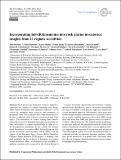Files in this item
Incorporating InSAR kinematics into rock glacier inventories : insights from 11 regions worldwide
Item metadata
| dc.contributor.author | Bertone, Aldo | |
| dc.contributor.author | Barboux, Chloé | |
| dc.contributor.author | Bodin, Xavier | |
| dc.contributor.author | Bolch, Tobias | |
| dc.contributor.author | Brardinoni, Francesco | |
| dc.contributor.author | Caduff, Rafael | |
| dc.contributor.author | Christiansen, Hanne H. | |
| dc.contributor.author | Darrow, Margaret M. | |
| dc.contributor.author | Delaloye, Reynald | |
| dc.contributor.author | Etzelmüller, Bernd | |
| dc.contributor.author | Humlum, Ole | |
| dc.contributor.author | Lambiel, Christophe | |
| dc.contributor.author | Lilleøren, Karianne S. | |
| dc.contributor.author | Mair, Volkmar | |
| dc.contributor.author | Pellegrinon, Gabriel | |
| dc.contributor.author | Rouyet, Line | |
| dc.contributor.author | Ruiz, Lucas | |
| dc.contributor.author | Strozzi, Tazio | |
| dc.date.accessioned | 2022-08-02T09:30:11Z | |
| dc.date.available | 2022-08-02T09:30:11Z | |
| dc.date.issued | 2022-07-14 | |
| dc.identifier | 280632897 | |
| dc.identifier | b4da58a1-e520-4c99-8032-4075543f5a1b | |
| dc.identifier | 85134395610 | |
| dc.identifier | 000824691700001 | |
| dc.identifier.citation | Bertone , A , Barboux , C , Bodin , X , Bolch , T , Brardinoni , F , Caduff , R , Christiansen , H H , Darrow , M M , Delaloye , R , Etzelmüller , B , Humlum , O , Lambiel , C , Lilleøren , K S , Mair , V , Pellegrinon , G , Rouyet , L , Ruiz , L & Strozzi , T 2022 , ' Incorporating InSAR kinematics into rock glacier inventories : insights from 11 regions worldwide ' , Cryosphere , vol. 16 , no. 7 , pp. 2769-2792 . https://doi.org/10.5194/tc-16-2769-2022 | en |
| dc.identifier.issn | 1994-0416 | |
| dc.identifier.other | RIS: urn:ACBBFA9F3696DA93AE20E81FE0388B28 | |
| dc.identifier.other | ORCID: /0000-0002-8201-5059/work/116597908 | |
| dc.identifier.uri | https://hdl.handle.net/10023/25762 | |
| dc.description | Funding: This research was funded by the European Space Agency Permafrost-CCI project (grant number 4000123681/18/I-NB). | en |
| dc.description.abstract | Rock glaciers are landforms related to permafrost creep that are sensitive to climate variability and change. Their spatial distribution and kinematic behaviour can be critical for managing water resources and geohazards in periglacial areas. Rock glaciers have been inventoried for decades worldwide, often without assessment of their kinematics. The availability of remote sensing data however makes the inclusion of kinematic information potentially feasible, but requires a common methodology in order to create homogeneous inventories. In this context, the International Permafrost Association (IPA) Action Group on rock glacier inventories and kinematics (2018-2023), with the support of the European Space Agency (ESA) Permafrost Climate Change Initiative (CCI) project, is defining standard guidelines for the inclusion of kinematic information within inventories. Here, we demonstrate the feasibility of applying common rules proposed by the Action Group in 11 regions worldwide. Spaceborne interferometric synthetic aperture radar (InSAR) was used to characterise identifiable moving areas related to rock glaciers, applying a manual and a semi-automated approach. Subsequently, these areas were used to assign kinematic information to rock glaciers in existing or newly compiled inventories. More than 5000 moving areas and more than 3600 rock glaciers were classified according to their kinematics. The method and the preliminary results were analysed. We identified drawbacks related to the intrinsic limitations of InSAR and to various applied strategies regarding the integration of non-moving rock glaciers in some investigated regions. This is the first internationally coordinated work that incorporates kinematic attributes within rock glacier inventories at a global scale. The results show the value of designing standardised inventorying procedures for periglacial geomorphology. | |
| dc.format.extent | 24 | |
| dc.format.extent | 15160046 | |
| dc.language.iso | eng | |
| dc.relation.ispartof | Cryosphere | en |
| dc.subject | GB Physical geography | en |
| dc.subject | QE Geology | en |
| dc.subject | DAS | en |
| dc.subject | MCC | en |
| dc.subject.lcc | GB | en |
| dc.subject.lcc | QE | en |
| dc.title | Incorporating InSAR kinematics into rock glacier inventories : insights from 11 regions worldwide | en |
| dc.type | Journal article | en |
| dc.contributor.institution | University of St Andrews. Environmental Change Research Group | en |
| dc.contributor.institution | University of St Andrews. Bell-Edwards Geographic Data Institute | en |
| dc.contributor.institution | University of St Andrews. School of Geography & Sustainable Development | en |
| dc.identifier.doi | https://doi.org/10.5194/tc-16-2769-2022 | |
| dc.description.status | Peer reviewed | en |
This item appears in the following Collection(s)
Items in the St Andrews Research Repository are protected by copyright, with all rights reserved, unless otherwise indicated.

